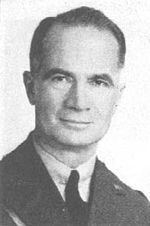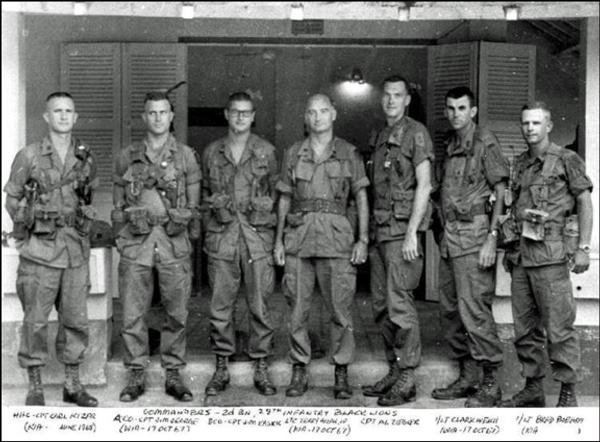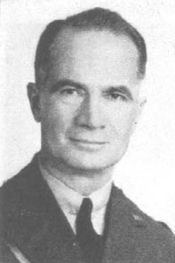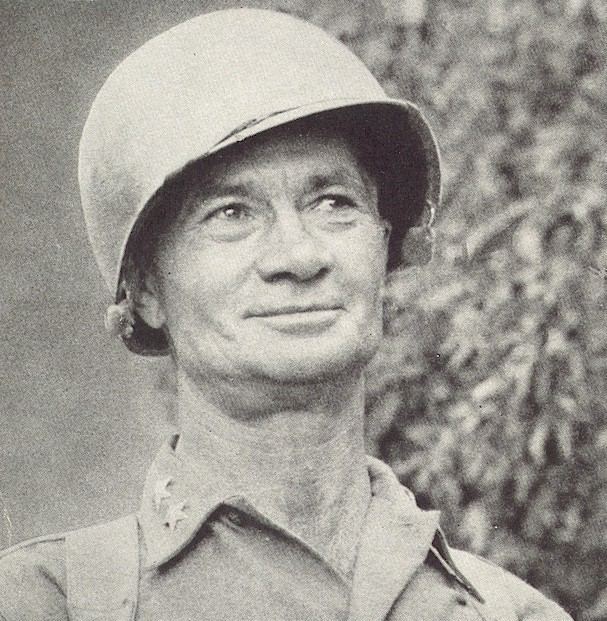Nickname(s) Terrible Terry Name Terry la Allegiance United States Role Sr. | Years of service 1912–1946 | |
 | ||
Born April 1, 1888Fort Douglas, Utah ( 1888-04-01 ) Battles/wars World War IBattle of Saint-MihielWorld War IIOperation TorchTunisia CampaignOperation HuskyBattle of the Bulge Battles and wars Battle of Saint-Mihiel, World War II | ||
Major General Terry de la Mesa Allen Sr. (April 1, 1888 – September 12, 1969) was a senior United States Army officer who fought in both World War I and World War II. Allen was a decorated World War I veteran who commanded the 1st Infantry Division in North Africa and Sicily from May 1942 until August 1943. He was later selected to lead the 104th Infantry Division as divisional commander, a post he held until the end of the war.
Contents
- Early years
- Command style
- Military career
- World War I
- Between the wars
- World War II
- Operation Torch
- Campaign in Sicily
- 104th Infantry Division
- Later years
- Honors
- Military awards and recognitions
- References

Early years

Allen was born in Fort Douglas, Utah, to Colonel Samuel Allen and Consuelo "Conchita" Alvarez de la Mesa. Allen's family had a long line of military tradition. Besides his father, Allen's maternal grandfather was Colonel Carlos Alvarez de la Mesa, a Spanish national who fought at Gettysburg for the Union Army in the Spanish Company of the "Garibaldi Guard", officially known as the 39th New York Volunteer Infantry Regiment, during the American Civil War. Allen grew up in various military bases because of his father's military career and in 1907, received an appointment to the United States Military Academy (West Point) in New York. Unlike most American World War II generals, Allen was also a Roman Catholic.
Command style
From all reports, Allen was not only respected but was warmly regarded by his troops of his 1st Infantry Division, particularly the enlisted men. Like General George Patton, Allen's superior for much of the war, Allen generally placed his headquarters far forward, as close to the front line as possible. Unlike Patton, however, Allen did not bother greatly with his military appearance, frequently going without clean uniforms and haircuts. He was also reportedly the only American general officer in the European and North African theaters who preferred to sleep on the ground, rather than on a cot or in a bed. However, despite a casual attitude toward his own personal appearance, Allen did not tolerate slovenliness or incompetence in the troops under his command. He expected his soldiers to keep their weapons and equipment in perfect working order and trained the men constantly to keep them combat ready.

As war correspondent Ernie Pyle, who was later killed in action, would write, "Major General Terry Allen was one of my favorite people. Partly because he didn't give a damn for hell or high water; partly because he was more colorful than most; and partly because he was the only general outside the Air Forces I could call by his first name. If there was one thing in the world Allen lived and breathed for, it was to fight. He had been all shot up in the last war, and he seemed not the least averse to getting shot up again. This was no intellectual war with him. He hated Germans and Italians like vermin."

In preparing the 1st Infantry Division for its first encounter with the enemy, Major General Allen emphasized realistic training exercises, weapons practice, and physical conditioning in the field in place of drill and military ceremony. He felt that the more time his men spent in training realistically, the better prepared they would be for combat with the highly trained and professional German Army. Allen had a distinct preference for night assaults, which he believed caused fewer casualties, and much time and effort was devoted to company and battalion-size night movements.
Military career
There were three certain factors which affected Allen's performance at West Point and which would lead up to his dismissal. One of them was that he began to stutter and soon fell behind in his classes. Another was that he was held back a grade in his second year because he failed mathematics. Finally, he failed an ordnance and gunnery course.
Allen enrolled and attended the Catholic University of America in Washington, D.C., and earned a Bachelor of Arts degree in 1912. He joined the United States Army once more and after passing the competitive army officers exam, was commissioned a second lieutenant of Cavalry Branch and assigned to Fort Myer, Virginia. In 1913, he was reassigned to the 14th Cavalry Regiment at Eagle Pass, Texas, and served there until 1917. During this time, he pursued and captured ammunition smugglers and served on border duty. He was promoted twice: on July 1, 1916, to first lieutenant and on May 15, 1917, to captain, almost six weeks after the American entry into World War I.
World War I
On June 7, 1918, fourteen months after the United States declared war against Germany and entered World War I, Allen was sent to France and assigned to the 315th Ammunition Train. Allen showed up at a school for infantry officers the day before a class graduation. When the commandant of the school began to hand out certificates to the graduates, Allen lined up with them. When confronted with him, the commandant said, "I don't remember you in this class." "I'm Allen. Why don't you?" was his reply. Without further ado, Allen was given the certificate and became a temporary major.
Allen was assigned to the 3rd Battalion of the 358th Infantry Regiment, part of the 90th Division of the American Expeditionary Force (AEF) which he led into battle on the Western Front at St. Mihiel and Aincreville. During one battle Allen received a bullet through his jaw and mouth and, as a result of the wound, never stuttered again. He was awarded a Silver Star and a Purple Heart for his actions. Allen remained with the AEF in France until the Armistice of November 11, 1918. He then served with the Army of Occupation in Germany until 1920 when he returned to the United States.
Between the wars
After Allen returned to the United States, his temporary rank of major was reverted to captain until July 1, 1920, when he was promoted to the permanent rank of major. He served in Camp Travis and later in Fort McIntosh, both located in Texas. In 1922, Allen was assigned to the 61st Cavalry Division, in New York City.
He continued to take military related courses, among them: an advanced course at the U.S. Army Cavalry School, Fort Riley, Kansas; a U.S. Army Command and General Staff School at Fort Leavenworth, Kansas; a course in the U.S. Army Infantry School at Fort Benning, Georgia and an interim course in infantry command with other divisions. In 1928, he married Mary Frances Robinson of El Paso, Texas with whom in 1929 he had a son, Terry Allen, Jr. On August 1, 1935, Allen was promoted to lieutenant colonel and became an instructor at the U.S. Army Cavalry School at Fort Riley, Kansas. He wrote and published "Reconnaissance by horse cavalry regiments and smaller units" in 1939.
On October 1, 1940, during World War II (although the United States was still neutral at this point) General George C. Marshall, Jr., the U.S. Army Chief of Staff, promoted him to the rank of brigadier general (without ever holding the rank of colonel) and commanded the 3rd Cavalry Brigade. From April–May 1941 he commanded the 2nd Cavalry Division. He then became the assistant division commander (ADC) of the 36th Infantry Division, an Army National Guard formation from Texas. The 36th Division was commanded by his good friend, Brigadier General Fred L. Walker.
World War II
In May 1942, five months after the Japanese attack on Pearl Harbor and the subsequent German declaration of war on the United States, he was promoted to the rank of major general and given command of the 1st Infantry Division.
Allen's 1st Infantry Division was soon sent to the United Kingdom where they underwent further combat training, which included training in amphibious operations. Allen and his ADC, Brigadier General Theodore Roosevelt Jr. (son of former President Theodore Roosevelt), distinguished themselves as combat leaders. Allen's brash and informal leadership style won him much respect and loyalty from the men in his division, who wholeheartedly adopted his emphasis on aggressiveness and combat effectiveness rather than military appearances. Another notable officer under his command was his chief of staff, Colonel Norman Cota, who would later become a major general and be remembered for his leadership on Omaha Beach during the invasion of Normandy on June 6, 1944, D-Day.
Operation Torch
The division participated in the invasion of French North Africa. The division landed in Oran, Algeria on November 8, 1942, as part of Center Task Force of Operation Torch under the command of Major General Lloyd Fredendall. Elements of the division then took part in combat in the Tunisia Campaign at Maktar, Medjez el Bab, Kasserine Pass, Gafsa, El Guettar, Béja, and Mateur, from January 21, 1943 to May 9, 1943, helping secure Tunisia. In July, 1943, the division participated in the Allied invasion of Sicily, codenamed Operation Husky. In a 3 March 1943 letter to the Army Chief of Staff, Marshall, General Dwight D. "Ike" Eisenhower, the Supreme Allied Commander in North Africa, expressed his confidence in the 1st Infantry Division's two leaders: "Terry Allen seems to be doing a satisfactory job; so is Roosevelt."
In spite of Allen's successes, Major General Omar Bradley, the II Corps commander, was highly critical of both Allen and Roosevelt's wartime leadership style. "While the Allies were parading decorously through Tunis," Bradley wrote, "Allen's brawling 1st Infantry Division was celebrating the Tunisian victory in a manner all its own. In towns from Tunisia all the way to Arzew, the division had left a trail of looted wine shops and outraged mayors. But it was in Oran...that the division really ran amuck. The trouble began when SOS (Services of Supply) troops, long stationed in Oran, closed their clubs and installations to our combat troops from the front. Irritated by this exclusion, the 1st Division swarmed into town to 'liberate' it a second time." Bradley continued: "Despite their [prodigious] talents as combat leaders, neither Terry Allen nor Brigadier General Theodore Roosevelt, the assistant division commander, possessed the instincts of a good disciplinarian. They looked upon discipline as an unwelcome crutch to be used by less able and personable commanders." Despite this, Bradley admitted that "none excelled the unpredictable Terry Allen in the leadership of troops."
Campaign in Sicily
Bradley's resentment of Allen stands in marked contrast to that of Patton, the U.S. Seventh Army commander in Sicily. Although Patton and Allen frequently argued and even insulted each other, particularly when discussing tactics and leadership styles, the former recognized Allen's competence in building a fighting division. When Patton heard General Eisenhower, the Supreme Allied Commander, deliver a lecture on the 'poor discipline' of Allen's 1st Division, Patton contradicted him: "I told him he was mistaken and that anyhow no one whips a dog before putting him into a fight." Nor did personalities dissuade Patton from fighting to get the 1st Infantry Division to carry out the Gela landings in Sicily, which he had correctly surmised would be the most difficult of the Allied assault landings in Sicily. When Patton learned that the 36th Infantry Division, commanded by Major General Fred Walker (whom Allen had served under as ADC during his time with the division), was to be used instead at Gela, he protested to General Eisenhower, claiming "I want those [1st Infantry Division] sons of bitches. I won't go without them!" Patton got his way.
With Patton occupied with the German evacuation from Messina and responding to official inquiries concerning his slapping of an enlisted soldier, Bradley used the opportunity to ask General Eisenhower permission to relieve both Allen and Roosevelt of their commands. Bradley ostensibly justified his request by stating that a change of senior command was needed in the 1st Division after the failure of the initial assault on Troina by the division. In reality, the first assault on Troina had been carried out by the 39th Infantry, a unit of the 9th Infantry Division that had been temporarily attached to Allen's 1st Division a few days prior to the attack. However, it served as a convenient pretext to relieve Allen, whose cocky and independent command style, while demonstrably effective, clashed with Bradley's idea of a commander. Even worse, in Bradley's mind, was that "the whole division had assumed Allen's cavalier attitude."
Although Bradley believed his actions caused Allen's relief, recent scholarship suggests that Allen's return to the United States was planned by Eisenhower and Patton before the Sicilian campaign began. Indeed, Eisenhower's statement on the matter from his personal papers was unequivocal: “It is a terrible injustice to General Allen to hint that he was relieved for inefficiency. The answer to this one is that I will be glad to have General Allen again as a division commander.”
On August 7, 1943, Allen was succeeded as 1st Infantry Division commander by Major General Clarence R. Huebner who, like Allen, was a distinguished veteran of World War I who had served with the 1st Division throughout the war.
104th Infantry Division
Allen was featured on the cover of Time Magazine on August 9, 1943. In October 1944 he was reassigned to command the 104th Infantry Division, known as the Timberwolf Division. Despite being relieved of command of the 1st Infantry Division, Allen continued his own style of leadership. Former 104th Infantry Division veterans remembered him as being "Confident, stubborn, determined, and aggressive." At the same time, Allen gave orders that he would not tolerate unshaven or slovenly troops–what he termed "Mauldins" in the Timberwolf Division.
While training the 104th in Arizona and Colorado, Allen stressed his own principles for combat success: "find 'em, fix 'em, fight 'em"..."take the high ground"..."inflict maximum damage to the enemy with minimum casualties to ourselves, night attack, night attack, night attack." The division extensively practiced night offensive operations to achieve maximum surprise and disruption of the enemy while reducing casualties from enemy artillery and machine gun fire.
Some 34,000 men served with the division under Allen, fighting for 195 consecutive days after landing in France on September 7, 1944. The division's first action came in October 1944 during the taking of Achtmaal and Zundert in the Netherlands. It then advanced through the Siegfried line to the Rhine River, crossing the Inde river into Cologne. Throughout his command of the division, Allen continued to display his independence and a hearty contempt for 'chickenshit' regulations that interfered with combat readiness, a trait which no longer seemed to infuriate his superior officers. After the 104th Division had secured its new lines, Bradley, now commanding the U.S. 12th Army Group, arrived in Cologne, Germany, to meet with Allen, stating "Terry, I'm pleasantly surprised to see these young Timberwolves of yours already ranked along with the First and the Ninth as the finest assault divisions in the ETO." Allen responded: "Brad, the First and the Ninth are in damned fast company."
The division later assisted in the encirclement of the Ruhr Pocket. Finally, it made a 350-mile sweep to the Mulde River in the heart of Germany as part of the Western Allied invasion of Germany. During the fighting on the Western Front, the 104th Infantry Division displayed its night fighting prowess in several successful operations.
In June 1946, over a year after Victory in Europe Day and the end of World War II in Europe, the 104th Infantry Division returned to the United States where it was deactivated.
Later years
Allen retired from the Army on August 31, 1946. For a number of years he served as a representative for various insurance companies in El Paso and was active in civic affairs and in veteran organizations. In October 1967, Allen's son, Lieutenant Colonel Terry de la Mesa Allen Jr., was killed in the Vietnam War, while commanding the 2nd Battalion, 28th Infantry Regiment, a unit of the 1st Infantry Division, which his father had commanded in World War II.
Allen Sr., died of natural causes on September 12, 1969, in El Paso, Texas, at the age of 81. He was buried, with his son and wife, in the Fort Bliss National Cemetery.
Honors
The United States Military Academy presents the "General Terry de la Mesa Allen Award" to the student with the highest rating in Military Science.
In February 1972, a community center in Fort Bliss was named for him. Although the building, adjacent to the Fort Bliss and Old Ironsides Museum, no longer functions as a community center, the dedication plaque was refurbished in late 2013 and remains as a tribute to Allen.
Military awards and recognitions
Among Major General Terry de la Mesa Allen Sr.'s military awards and recognitions are the following:
Foreign Decorations
